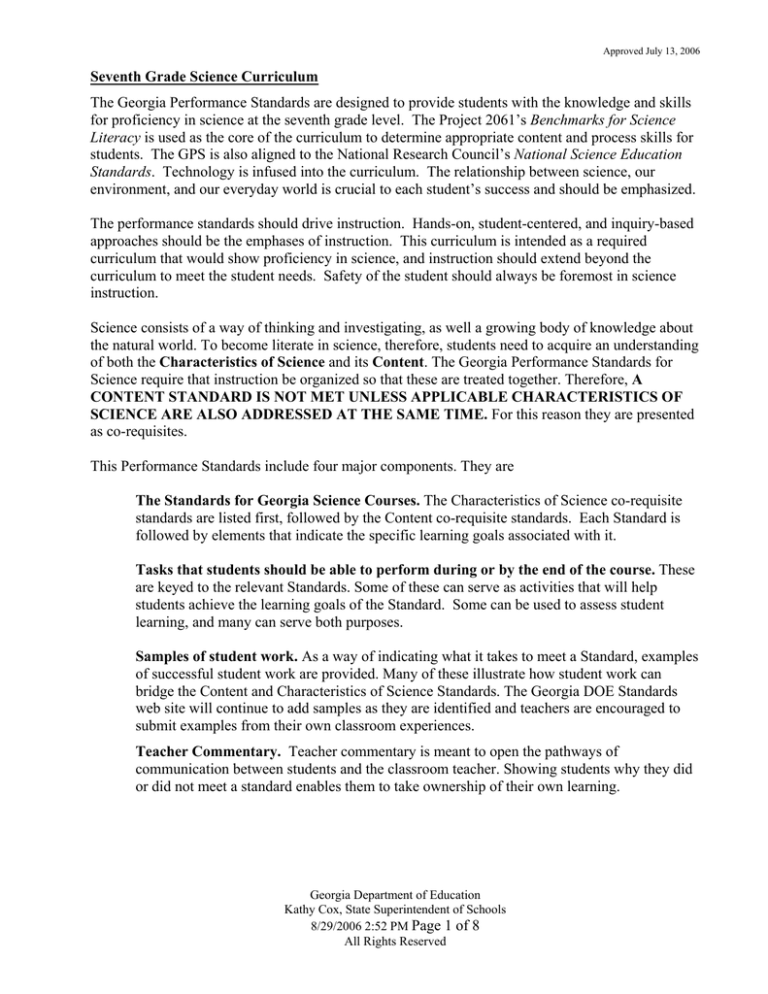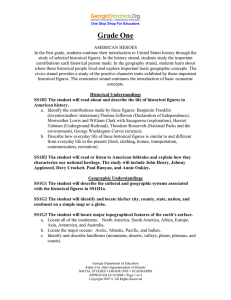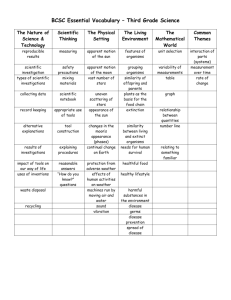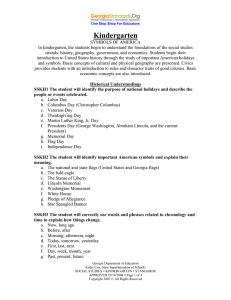
Approved July 13, 2006
Seventh Grade Science Curriculum
The Georgia Performance Standards are designed to provide students with the knowledge and skills
for proficiency in science at the seventh grade level. The Project 2061’s Benchmarks for Science
Literacy is used as the core of the curriculum to determine appropriate content and process skills for
students. The GPS is also aligned to the National Research Council’s National Science Education
Standards. Technology is infused into the curriculum. The relationship between science, our
environment, and our everyday world is crucial to each student’s success and should be emphasized.
The performance standards should drive instruction. Hands-on, student-centered, and inquiry-based
approaches should be the emphases of instruction. This curriculum is intended as a required
curriculum that would show proficiency in science, and instruction should extend beyond the
curriculum to meet the student needs. Safety of the student should always be foremost in science
instruction.
Science consists of a way of thinking and investigating, as well a growing body of knowledge about
the natural world. To become literate in science, therefore, students need to acquire an understanding
of both the Characteristics of Science and its Content. The Georgia Performance Standards for
Science require that instruction be organized so that these are treated together. Therefore, A
CONTENT STANDARD IS NOT MET UNLESS APPLICABLE CHARACTERISTICS OF
SCIENCE ARE ALSO ADDRESSED AT THE SAME TIME. For this reason they are presented
as co-requisites.
This Performance Standards include four major components. They are
The Standards for Georgia Science Courses. The Characteristics of Science co-requisite
standards are listed first, followed by the Content co-requisite standards. Each Standard is
followed by elements that indicate the specific learning goals associated with it.
Tasks that students should be able to perform during or by the end of the course. These
are keyed to the relevant Standards. Some of these can serve as activities that will help
students achieve the learning goals of the Standard. Some can be used to assess student
learning, and many can serve both purposes.
Samples of student work. As a way of indicating what it takes to meet a Standard, examples
of successful student work are provided. Many of these illustrate how student work can
bridge the Content and Characteristics of Science Standards. The Georgia DOE Standards
web site will continue to add samples as they are identified and teachers are encouraged to
submit examples from their own classroom experiences.
Teacher Commentary. Teacher commentary is meant to open the pathways of
communication between students and the classroom teacher. Showing students why they did
or did not meet a standard enables them to take ownership of their own learning.
Georgia Department of Education
Kathy Cox, State Superintendent of Schools
8/29/2006 2:52 PM Page 1 of 8
All Rights Reserved
Approved July 13, 2006
Georgia Performance Science Standards-- Explanation of Coding
Characteristics of Science Standards
SKCS1
Science Kindergarten Characteristics of Science Standard #1
S8CS2
Science Grade 8 Characteristics of Science Standard #2
SCSh8
Science Characteristics of Science high school Standard #8
Content Standards
S5P3
Science Grade 5 Physical Science Standard #3
S4E2
Science Grade 4 Earth Science Standard #2
S7L4
Science Grade 7 Life Science Standard #4
SC1
Science Chemistry Standard #1
SB4
Science Biology Standard #4
SPS6
Science Physical Science Standard #6
SP3
Science Physics Standard #3
Georgia Department of Education
Kathy Cox, State Superintendent of Schools
8/29/2006 2:52 PM Page 2 of 8
All Rights Reserved
Approved July 13, 2006
Seventh grade students keep records of their observations and use those records to analyze the data
they collect. They observe and use observations to explain diversity of living organisms and how
the organisms are classified. They use different models to represent systems such as cells, tissues,
and organs. They use what they know about ecosystems to explain the cycling of matter and energy.
They use the concepts of natural selection and fossil evidence in explanations. Seventh graders write
instructions, describe observations, and show information in graphical form. When analyzing the
data they collect, seventh graders can recognize relationships in simple charts and graphs and find
more than one way to interpret their findings. The students replicate investigations and compare
results to find similarities and differences.
The middle school life science course is designed to give students the necessary skills for a smooth
transition from elementary life science standards to high school biology standards. The purpose is to
give all students an overview of common strands in life science including, but not limited to,
diversity of living organisms, structure and function of cells, heredity, ecosystems, and biological
evolution.
Major Concepts/ Skills:
Diversity of living organisms
Dichotomous key/classify (6 Kingdoms)
Structure and function of cells
Tissues, organs, and organ systems
Purpose of major human body organ systems
Heredity, genes, and successive generations
Ecosystems
Cycling of matter and energy
Biological evolution
Natural selection and fossil record
Concepts/Skills to Maintain:
Characteristics of Science
Records investigations clearly and accurately
Uses hypotheses
Uses technology
Uses safety techniques
Uses scientific tools
Writes clearly
Organizes data into graphs/tables/charts
Interprets graphs/tables/charts
Asks quality questions
Analyzes/organizes scientific data via
calculations and inference
Recognizes the importance of explaining data
with precision and accuracy
Co-Requisite – Characteristics of Science
Habits of Mind
S7CS1. Students will explore of the importance of curiosity, honesty, openness, and
skepticism in science and will exhibit these traits in their own efforts to understand
how the world works.
a. Understand the importance of—and keep—honest, clear, and accurate records in
science.
b. Understand that hypotheses can be valuable, even if they turn out not to be
completely accurate.
Georgia Department of Education
Kathy Cox, State Superintendent of Schools
8/29/2006 2:52 PM Page 3 of 8
All Rights Reserved
Approved July 13, 2006
S7CS2. Students will use standard safety practices for all classroom laboratory and field
investigations.
a. Follow correct procedures for use of scientific apparatus.
b. Demonstrate appropriate techniques in all laboratory situations.
c. Follow correct protocol for identifying and reporting safety problems and violations.
S7CS3. Students will have the computation and estimation skills necessary for analyzing data
and following scientific explanations.
a. Analyze scientific data by using, interpreting, and comparing numbers in several
equivalent forms, such as integers, fractions, decimals, and percents.
b. Use the mean, median, and mode to analyze a set of scientific data.
c. Apply the metric system to a scientific investigation that includes metric to metric
conversion. (i.e. centimeters to meters)
d. Draw conclusions based on analyzed data.
e. Decide what degree of precision is adequate, and round off appropriately.
f. Address the relationship between accuracy and precision and the importance of each.
S7CS4. Students will use tools and instruments for observing, measuring, and manipulating
equipment and materials in scientific activities.
a. Use appropriate technology to store and retrieve scientific information in topical,
alphabetical, numerical, and keyword files, and create simple files.
b. Use appropriate tools for measuring objects and/or substances.
c. Learn and use on a regular basis standard safety practices for scientific investigations.
S7CS5. Students will use the ideas of system, model, change, and scale in exploring scientific
and technological matters.
a. Observe and explain how parts can be related to other parts in a system such as
predator/prey relationships in a community/ecosystem.
b. Understand that different models (such as physical replicas, pictures, and analogies)
can be used to represent the same thing.
S7CS6. Students will communicate scientific ideas and activities clearly.
a. Write clear, step-by-step instructions for conducting particular scientific
investigations, operating a piece of equipment, or following a procedure.
b. Write for scientific purposes incorporating data from circle, bar and line graphs, twoway data tables, diagrams, and symbols.
c. Organize scientific information using appropriate simple tables, charts, and graphs,
and identify relationships they reveal.
S7CS7. Students will question scientific claims and arguments effectively.
a. Question claims based on vague attributions (such as “Leading doctors say...”) or on
statements made by people outside the area of their particular expertise.
b. Identify the flaws of reasoning that are based on poorly designed research (i.e., facts
intermingled with opinion, conclusions based on insufficient evidence).
c. Question the value of arguments based on small samples of data, biased samples, or
samples for which there was no control.
d. Recognize that there may be more than one way to interpret a given set of
findings.
Georgia Department of Education
Kathy Cox, State Superintendent of Schools
8/29/2006 2:52 PM Page 4 of 8
All Rights Reserved
Approved July 13, 2006
The Nature of Science
S7CS8. Students will investigate the characteristics of scientific knowledge and how that
knowledge is achieved.
Students will apply the following to scientific concepts:
a. When similar investigations give different results, the scientific challenge is to judge
whether the differences are trivial or significant, which often requires further study.
Even with similar results, scientists may wait until an investigation has been repeated
many times before accepting the results as meaningful.
b. When new experimental results are inconsistent with an existing, well-established
theory, scientists may pursue further experimentation to determine whether the
results are flawed or the theory requires modification.
c. As prevailing theories are challenged by new information, scientific knowledge may
change.
S7CS9. Students will investigate the features of the process of scientific inquiry.
Students will apply the following to inquiry learning practices:
a. Investigations are conducted for different reasons, which include exploring new
phenomena, confirming previous results, testing how well a theory predicts, and
comparing competing theories.
b. Scientific investigations usually involve collecting evidence, reasoning, devising
hypotheses, and formulating explanations to make sense of collected evidence.
c. Scientific experiments investigate the effect of one variable on another. All other
variables are kept constant.
d. Scientists often collaborate to design research. To prevent this bias, scientists conduct
independent studies of the same questions.
e. Accurate record keeping, data sharing, and replication of results are essential for
maintaining an investigator’s credibility with other scientists and society.
f. Scientists use technology and mathematics to enhance the process of scientific
inquiry.
g. The ethics of science require that special care must be taken and used for human
subjects and animals in scientific research. Scientists must adhere to the appropriate
rules and guidelines when conducting research.
Georgia Department of Education
Kathy Cox, State Superintendent of Schools
8/29/2006 2:52 PM Page 5 of 8
All Rights Reserved
Approved July 13, 2006
Reading Standard Comment
After the elementary years, students are seriously engaged in reading for learning. This process
sweeps across all disciplinary domains, extending even to the area of personal learning. Students
encounter a variety of informational as well as fictional texts, and they experience text in all genres
and modes of discourse. In the study of various disciplines of learning (language arts, mathematics,
science, social studies), students must learn through reading the communities of discourse of each of
those disciplines. Each subject has its own specific vocabulary, and for students to excel in all
subjects, they must learn the specific vocabulary of those subject areas in context.
Beginning with the middle grades years, students begin to self-select reading materials based on
personal interests established through classroom learning. Students become curious about science,
mathematics, history, and literature as they form contexts for those subjects related to their personal
and classroom experiences. As students explore academic areas through reading, they develop
favorite subjects and become confident in their verbal discourse about those subjects.
Reading across curriculum content develops both academic and personal interests in students. As
students read, they develop both content and contextual vocabulary. They also build good habits for
reading, researching, and learning. The Reading Across the Curriculum standard focuses on the
academic and personal skills students acquire as they read in all areas of learning.
S7CS10. Students will enhance reading in all curriculum areas by:
a. Reading in All Curriculum Areas
• Read a minimum of 25 grade-level appropriate books per year from a variety of
subject disciplines and participate in discussions related to curricular learning in
all areas
• Read both informational and fictional texts in a variety of genres and modes of
discourse
• Read technical texts related to various subject areas
b. Discussing books
• Discuss messages and themes from books in all subject areas.
• Respond to a variety of texts in multiple modes of discourse.
• Relate messages and themes from one subject area to messages and themes in
another area.
• Evaluate the merit of texts in every subject discipline.
• Examine author’s purpose in writing.
• Recognize the features of disciplinary texts.
c. Building vocabulary knowledge
• Demonstrate an understanding of contextual vocabulary in various subjects.
• Use content vocabulary in writing and speaking.
• Explore understanding of new words found in subject area texts.
d. Establishing context
• Explore life experiences related to subject area content.
• Discuss in both writing and speaking how certain words are subject area related.
• Determine strategies for finding content and contextual meaning for unknown
words.
Georgia Department of Education
Kathy Cox, State Superintendent of Schools
8/29/2006 2:52 PM Page 6 of 8
All Rights Reserved
Approved July 13, 2006
Co-Requisite – Content
S7L1. Students will investigate the diversity of living organisms and how they can be
compared scientifically.
a. Demonstrate the process for the development of a dichotomous key.
b. Classify organisms based on physical characteristics using a dichotomous key of the
six kingdom system (archaebacteria, eubacteria, protists, fungi, plants, and animals).
S7L2. Students will describe the structure and function of cells, tissues, organs, and organ
systems.
a. Explain that cells take in nutrients in order to grow and divide and to make needed
materials.
b. Relate cell structures (cell membrane, nucleus, cytoplasm, chloroplasts,
mitochondria) to basic cell functions.
c. Explain that cells are organized into tissues, tissues into organs, organs into systems,
and systems into organisms.
d. Explain that tissues, organs, and organ systems serve the needs cells have for oxygen,
food, and waste removal.
e. Explain the purpose of the major organ systems in the human body (i.e., digestion,
respiration, reproduction, circulation, excretion, movement, control, and
coordination, and for protection from disease).
S7L3. Students will recognize how biological traits are passed on to successive generations.
a. Explain the role of genes and chromosomes in the process of inheriting a specific
trait.
b. Compare and contrast that organisms reproduce asexually and sexually (bacteria,
protists, fungi, plants & animals).
c. Recognize that selective breeding can produce plants or animals with desired traits.
S7L4. Students will examine the dependence of organisms on one another and their
environments.
a. Demonstrate in a food web that matter is transferred from one organism to another
and can recycle between organisms and their environments.
b. Explain in a food web that sunlight is the source of energy and that this energy moves
from organism to organism.
c. Recognize that changes in environmental conditions can affect the survival of both
individuals and entire species.
d. Categorize relationships between organisms that are competitive or mutually
beneficial.
e. Describe the characteristics of Earth’s major terrestrial biomes (i.e. tropical rain
forest, savannah, temperate, desert, taiga, tundra, and mountain) and aquatic
communities (i.e. freshwater, estuaries, and marine).
S7L5. Students will examine the evolution of living organisms through inherited
characteristics that promote survival of organisms and the survival of successive
generations of their offspring.
a. Explain that physical characteristics of organisms have changed over successive
generations (e.g. Darwin’s finches and peppered moths of Manchester).
Georgia Department of Education
Kathy Cox, State Superintendent of Schools
8/29/2006 2:52 PM Page 7 of 8
All Rights Reserved
Approved July 13, 2006
b. Describe ways in which species on earth have evolved due to natural selection.
c. Trace evidence that the fossil record found in sedimentary rock provides evidence for
the long history of changing life forms.
Georgia Department of Education
Kathy Cox, State Superintendent of Schools
8/29/2006 2:52 PM Page 8 of 8
All Rights Reserved












